
| Wes Boyd's Spearfish Lake Tales Contemporary Mainstream Books and Serials Online |

Upper Granite Gorge, Adrenaline Alley, Bass Camp (Mile 108)

| Wes Boyd's Spearfish Lake Tales Contemporary Mainstream Books and Serials Online |

I slept pretty well. It got a little chilly toward morning, but I snuggled down in the bag and put up with it rather than pulling on the fleece that lay close at hand -- it probably would have been too much, anyway. Practice made getting around in the morning a little more organized, and not having a tent made it a lot simpler. Today would be a big day, I knew, with lots of getting wet, so I left the polypro underwear on for an extra layer, rather than packing it up as in past mornings, and hoped it wouldn't get too warm.
The river had come up some overnight, changing what had been a simple walk along the bank and a short climb into a scramble through the tamarisk to get to the kitchen. After hauling the first bag down to the beach, I got a cup of coffee and took advantage of no line at the groover to make use of it. Once again, the crew had made good use of Fletcher's dictum, and the view from the rocket box was particularly good this morning, looking out over the river.
Breakfast was soon served, pancakes and sausage -- very good, indeed. It went quickly, and soon we were loading the rafts and getting things tied down extra tight -- with only one exception, we'd face the biggest rapids of the trip today, and the biggest concentration of them we would see.
The first of them was right around the corner, Unkar, which we ran in the shadow of a canyon wall under the otherwise bright, clear blue sky. Unkar was one of the heaviest rapids we'd seen so far, but we were getting a little used to the drill by now, and though we got wet, it was only the first time of many. We ran on for another couple of miles to the next rapid, Nevills, somewhat smaller than Unkar, but with a nasty rock right in the tongue.
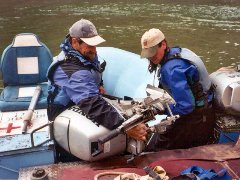 |
|
Joe and Parker changing the motor after a mishap in Nevills Rapids that bent the throttle arm. |
Parker was at the motor today -- she hadn't run some of these rapids at the helm before, and Joe wanted to give her the experience. Usually she did great, but this time one of those little accidents happened. I'm still not quite clear on what happened, but apparently while she was trying to raise the motor with what's called the "jackass arm", she wasn't quite quick enough, and the lower unit hit the rock, throwing us sideways. The lurch threw her against the throttle arm, putting about a ten degree bend in it. We got flushed sideways over another large rock -- we could feel the boat bump over it -- and backwards out the bottom of the rapids without other apparent damage, but handling the motor was difficult. With a little bit of trouble, Joe and Parker nosed the raft into shore. A serious look at the motor revealed the damage, and it was clearly time to change to the spare motor. Joe and Parker managed the change in about ten minutes, and Joe told me later that he hoped that the accident hadn't made Parker nervous, what with what was coming up.
What was coming up was Hance, the third toughest rapids on the river. The canyon narrows here; we'd reached the hard Vishnu Schist, a metamorphic rock, sandstone compressed by heat and pressure and time into a black, shiny rock that the river doesn't cut very easily. Gone were the wide views and easy slopes; the walls of the Canyon rose above on each side nearly vertically, with few spots for landing and not much chance to rest.
Just above Hance, we nosed into a small talus pile so the boatmen, and others that wished to, could go up and scout the rapid prior to running it. It was a steep froth of water, with considerable drop, but at least the line through it was fairly clear. Soon, we were back on the boats, settling down into the heavy water positions and hanging on as Parker backed us out into the current and pointed us downstream.
When you fall off the horse, the best thing to do is to get back on it, the old saw goes, and so it proved for Parker. She ran it perfectly, the raft bucking up and down in the waves, with us passengers -- and the boatmen -- being continually splashed by walls of green water that splashed up over the bow of the raft as it nosed into the huge waves. When we finally reached the quiet water below Hance, we all let out a yell, and threw congratulations back at Parker, who had a deserved big grin on her face following the great ride.
The next rapid downstream, Sockdolager, was not as tough a ride as Hance but technically more difficult, and it proved that to Parker and the rest of us. I'm not too clear how it happened, but partway down the rapids I guess she got the raft a little too far over the eddy fence, and we were spun around, bounced the side tube off one of the canyon walls, spun the other way around, took another canyon wall on the nose -- fortunately not hard, and we only bounced off that -- these big boats will take hits like that. We wound up getting spat out of Sockdolager backwards, not the worse for wear, wet and relieved. These big boats will take mistakes and abuse, and mistakes are a part of training, after all, but the incident showed just how ultimately safe these big boats really are, and how much room for error there is.
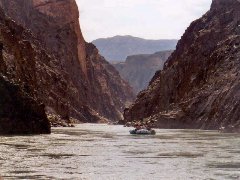 |
|
Josh's raft following us in Upper Granite Gorge, somewhere below Sockdolager. |
We proceeded on down the Canyon as the skies clouded up, and it almost looked like we were in for more rain, but it must have only been a line for soon it cleared off to scattered cumulus, and it got warm. The next several miles had a couple smaller rapids -- well, smaller than Hance, anyway, although some were as big as anything we had run the first day. We thrilled to the steep canyon walls, the interesting steep, narrow side canyons, and the patterns of the black schist. (Yes, the word "schist" was the cause of many bad puns, but I'll spare the reader . . .)
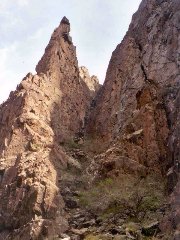 |
|
Pinnacle in Upper Granite Gorge, nearing the Phantom Ranch area. |
Nine miles below Sockdoglar, we got to the "populated" area near Phantom Ranch. Here we would see about the most signs of man that we would see anywhere between Lee's Ferry and Lake Mead. First, the Kaibab Trail Bridge went overhead, and we passed a cable stretched overhead as part of the river gauging station. There was a landing shortly below, and several rafts were pulled up there, doubtlessly to let the passengers hike the half mile up to Phantom Ranch and its telephones and store, but we didn't stop. We went on through a small rapids right at the Bright Angel Bridge (Mile 88), got a glance at the Bright Angel Trail working its way down the steep cliff -- making me glad I didn't decide to walk down there, after all. A mile or so down stream we went through Pipe Springs Rapid, where many of the half-trips make their exchange, got another glance as the Bright Angel Trail, and civilization, such as it was, was gone.
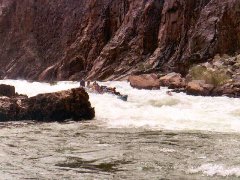 |
|
Josh's raft running Horn Creek Rapid, below Phantom. Worse was to come. |
A mile or so was Horn Creek Rapid, another tough one, the first of four really big ones below Phantom Ranch that we'd face this afternoon. Horn Creek has a very narrow entrance between two large rocks, but Parker aced it, and we pulled out in the eddy below. There's a nice small beach and a narrow side canyon just below Horn Creek, and it was a good place to stop for lunch, and, in my mind, one of the prettier lunch stops. Lunch was cold cuts, and I found a shady spot along the dry wash to sit and balance my blood nicotine level and work on my notes.
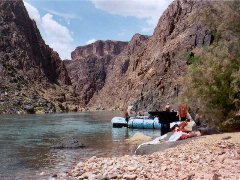 |
|
Lunch stop just below Horn Creek Rapid. |
While hanging around, Joe told us a story of the last trip he'd been on down there, only a few weeks before. This was the seminar trip, and apparently was a bit on the casual side, as it had various sorts of rafts, along with kayaks. One kayaker came blasting through a particularly exhilarating run of Horn Creek, at the bottom let out a big yell and shouted, "Wow! That was outdoorsy!" We'd hear that phrase over and over again for the rest of the trip.
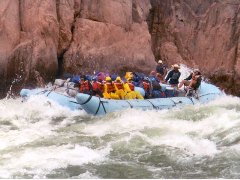 |
|
Josh's raft running Granite Rapids. |
We didn't linger long at the lunch stop, but were soon back on the river. The Colorado ran fast here, and we covered the three miles to Granite in a hurry, under skies that were clouding up again, and soon came to Granite Rapid, which had a tough bend in the center. Again, we crashed through the huge, bucking waves, getting wet in the process, and ran on another couple miles in a few minutes to Hermit, just at tough, and getting just as wet. Farther on, we ran a smaller rapid, Boucher, and now under a solid overcast pulled in just above the next rapid, Crystal to look it over.
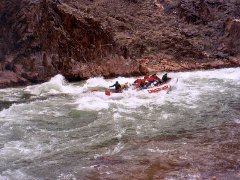 |
|
Grand Canyons Expeditions Raft running Crystal Rapid -- a wild ride! |
Crystal, at Mile 98 has a reputation, and it's well deserved. At one time, it was considered the worst rapid on the river, and it's flipped a lot of rafts, although at somewhat higher levels than we saw. It's relatively new; formed by a flash flood in 1966, and at higher levels than are commonly seen today, especially in 1983, it was a killer. Frankly, I was more concerned about Crystal than I was about any other rapid on the river, so I joined virtually everybody else in walking up through a boulder field under gray skies to look it over. Huge waves, huge hydraulics were easily in evidence. As we stood there watching, a trip from Grand Canyon Expeditions came through without scouting, and at least one raft got a little crossed up in the lower part. Supposedly, the right side run at Crystal is the "sneak" route, but it takes some maneuvering that was beyond our big rafts. The center run was the planned one, rough, but doable; you're supposed to stay out of the left side due to big waves crashing in from reflections along the left wall. There was nothing to do but run it. We got back on the rafts, dug in, hung on, and Parker motored us out into the river.
The run down the river, a little to the right of center, started perfectly. Again, I'm not real clear on how it happened since I was looking out the wrong side of the raft and it happened pretty quickly, but somehow a cross wave or an eddy or something caught us, wrapped us sideways, shot us over the center line, spun us around, and down the hairy left line we went, backwards, with Parker trying to get the boat spun around to at least proceed down though this monster in normal fashion. She did finally get back under control as we went through the lower part, still crashing into huge waves, spray and green water crashing aboard, getting us all soaked. We teased Parker for the rest of the trip about how she'd made the left run at Crystal backwards, just to prove it could be done -- and once again, it proved that these big boats are pretty safe, after all.
Frankly, the rest of the afternoon is a little bit of a blur. The scenery was awesome, and we ran a lot of rapids, many of them wet, many of them where we had to hang on tight while waves crashed over us, but none anywhere near as intimidating as Crystal had been. These rapids are known as the Jewels -- while an odd jewel, Tuna, snuck in there somehow, the next few are Agate, Sapphire, Turquoise, and Ruby. Serpentine and 104 Mile also snuck in there somehow. Early in the run, we passed "Nixon Rock" -- Joe said it was because "It's a little to the right and you can't get enough water to cover it up." Finally, we reached Bass Rapid, where a trail comes down from the rim to an old camp, right in the middle of the rapids. A private party was camped at a small camp there, and Joe ran us on to Bass Camp, on river right, at 108 Mile.
The last four camps of the trip were all pretty nice, and it would be hard to pick the best one, but on reflection, I think it would have to be this one, by a narrow margin. It was large and open, with a few rock outcroppings, but a hard sand surface on most of it. We had a little virga sprinkle just as we landed, but it was just a few drops, and I'd already decided to sleep outside again. A pretty good breeze was blowing, and I hunted around for a good place to call home for the night -- "Indecision is the key to flexibility" -- and finally settled on a protected spot in some tamarisks ten feet or so above the river. It was not a large spot, but big enough, and soon the trees were hanging with wet clothes, polypro and raingear and whatnot. I spread out a little, did some chores, and after a while Joe announced a short hike up a small sidecanyon to a waterfall on Shinumo Creek.
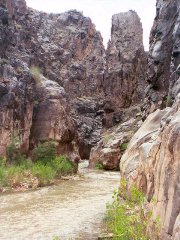 |
|
Shinumo Creek running high, keeping us from hiking up to a waterfall. No matter; we were off the river after a tough day. |
With rafts unloaded now, we all clambered aboard and ran a couple hundred yards down to a poor landing, and climbed up over a small talus slope and down the other side, to discover the creek running high and muddy from some rainstorm up the canyon -- obviously not a safe place to go, under the circumstances. A little disappointed, we turned back, got on the rafts, and headed back to the camp.
The batteries in Jason's cameras were getting low -- and he used a lot of batteries -- but ARR had brought a portable generator to charge them. Although the generator wasn't particularly loud, no one particularly wanted the noise of the generator around the camp -- the noise of the outboard motors was irritating enough among the natural sounds and silence of the canyon, so Josh and Jay loaded the generator and battery packs aboard his raft, and headed back down to the tieup at Shinumo Canyon to charge them, making sure they took a drag bag with them. They were down there for a couple hours, just hanging out and taking it easy while the motor did its put-put routine.
With some time to kill, I decided to take a bath -- besides, my pants could use some hang time to dry out. The Supplex clothes -- shirt from Cabelas, pants from Bass Pro Shops -- were a blessing. Advertised as "quick dry", they were indeed that. Sometimes they'd get wet a dozen times or more a day -- more this day -- and usually, if we didn't hit another big rapid, they'd be dry within minutes in the low humidity and wind of the Canyon. I can't imagine doing this trip wearing cotton, although many did. They were long pants, and the shirts had long sleeves, so I never had to apply sunscreen to more than my hands and face, and didn't get more than a touch of sunburn, which is easy to get down in the Canyon and which has made many a trip miserable.
Wearing my swimsuit, I headed down to the river, next to one of the rafts. Yes, that sucker was cold! I could get into it up to my waist all right and soaped down pretty good, but to rinse I had to duck under water, and I told Joe, sitting on the raft diddling with something, "All right, here we go with the involuntary gasp reflex", and ducked under. Yeeeehaaa, it was cold! I didn't stay in long after that, but dried off quickly once out of the water and in the warmth of the dying sun.
As a consolation prize, Joe offered to lead a hike far up the canyon to a little butte we could see high overhead, and he had some takers, but I wasn't one of them, preferring to put to the side what would obviously be a tough climb, for the sake of sitting around camp and tapping the drag bags a couple of times myself. "You know you've had a tough day," Dick commented while pawing through a drag bag, "When the paint is sanded off the beer cans". After one of the regular MGD hunts -- made harder by the removed paint -- I had an unopened beer in my hand as I walked back on one of the rafts to take advantage of one of the boatmen's seats -- it had a back, and I'd appreciate the rest -- when I slipped on a boat cushion and wound up crashing into a side tube, skinning my knee on a side board. I picked my self up, cussed a little, drank the beer, had a cigarette or two, then headed back up to camp, carrying another beer, and ran my head right straight into a nubbin where a tamarisk had lost a branch. All right, two strikes, and I wasn't looking forward to number three.
The tamarisks are interesting. They're an imported, invasive species, and are established all along the river bank on virtually all the sand bars, sometimes in thick pockets. They're not a big tree -- big ones run ten or twelve feet -- but they've pretty well crowded out the natural cottonwoods. They have a thin, fine leaf, and add a welcome touch of green to an otherwise earth tone landscape. Efforts were made in the past to control them, to no avail, and now they're spreading up the side canyons. Joe told us that he'd made a trip with the National Park Service in November to go and cut back tamarisks in some of the side canyons, where they're taking over, causing problems for several endangered species that depend on the natural willows.
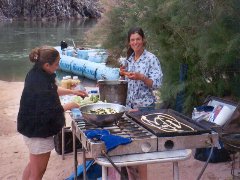 |
|
Lynn and Parker working on dinner at Bass Camp, our fourth night out. |
The hikers got back some time later, just as it was getting to be time for dinner, and reported seeing a big thunderstorm to the north, which was probably the cause of Shinumo Creek running high. Dinner was grilled pork chops and baked beans and applesauce, very good, and again it was hard to avoid overeating, and again it was getting dark as it finished.
Since the grill had been set up, Joe used the opportunity to throw half a Dura-Log in it after dinner, and a number of us sat around shooting the bull until late, in best campfire tradition. The talk ranged over a lot of things, but much of it was concentrated on Troy, his plans to start an outdoor expeditions business of his own and his decision on whether to get started on the business plan he's already written, or go ahead and get his Master's first. Somehow the talk drifted to computers and the Internet, and there were a number of us there that were Internet old-timers -- in other words, we go back before graphic web browsers, to the days of 2400 baud modems -- and slower. One guy told of saving money from his paper route to spend $700 on a 1200 baud high speed modem. These young punks don't know how tough we had it in the bad old days. From there, it drifted to the restaurant business, and on to other things, just like any good free-form campfire discussion. Finally, one by one, we drifted off to bed.




